Famous Koki Roti from Sindhi cuisine now made with Jowar flour and thus turning it gluten-free. Thus sharing with you a tasty and healthier version of Koki roti that is full of vegetables, spices, herbs and uses very little ghee.
It is one of the easiest and yummiest preparations using Jowar flour.
I am enjoying trying out various popular recipes with millets in my millet series. Apart from millet cakes and cookies, millet Litti Chokha, millet Bisi Bele Bhat, millet Pizza, Ragi Dosa, millet Idli have all come out good and worth replacing the usual wheat and rice in future too.
What Is Koki?
Koki is a Sindhi delicacy and though can be had at any time of the day but is popular as a breakfast item. The name 'Koki' itself is enough to lure anyone, especially if Sindhi. It can be made either sweet or savoury. And today, I am sharing here the savoury one.
It is a flatbread, a very heavy and slightly thick Roti loaded with ghee along with herbs.
As I always prefer to learn new dishes from someone who makes them regularly so this time too I turned to my Sindhi friend, Sharon Nathani. And I am really glad I did as got to know an easy way of making this unique dish.
Surprisingly, she, despite liking it a lot, doesn't eat this Roti. Can you guess why? For the simple reason that it is made with so much of Ghee. When asked her why not make with less ghee, her humble reply was that then it doesn't taste that good.
What's Special About this Sindhi Delicacy?
- Apart from the taste, this roti is crisp and has a different texture. Firstly, ghee, onions, herbs and spices are added to wheat flour and then the dough is just made without kneading much. This is because if kneaded then it will give rise to gluten which in turn would make Rotis soft. And we want a crispy texture.
- Another unique thing about it is that it is cooked twice. Yes, rolled chapati is half cooked then crumbled, again rolled and then cooked. In simple words, roll-cook-dismantle-roll-cook till crisp. This is the simple but unique way of making Koki Roti.
- It is thicker than normal Roti or Paratha.
Tip: An authentic version of Koki Roti uses only onions, ginger, cilantro and spices. But we can always use veggies like bottle gourd, carrot etc and make it fibre rich, the way I have added in the Jain version of Koki Roti. It is a good way to feed veggies to children without making anything obvious.
Why Do I Make Koki with Jowar Flour
As Koki dough is made without kneading much and has rough ends too, then an idea struck me as to why not make this with gluten-free flour only. With this flour, the edges would remain uneven only without any worry of gluten being developed.
Also, as I was making it with a healthy flour so to maintain its health quotient, I used little ghee and added curd to it to get a moist dough. Again, if you are fond of ghee then omit curd and add more ghee to the flour.
Lower the quantity of ghee and it is indeed a healthy flatbread with the goodness of veggies and spices. And when made with Jowar flour it is ultimate as it brings with it the benefits of this wonder flour.
Not only it becomes gluten-free but is perfect for diabetic as well as heart patients.
Read more about Jowar in my All About Millets
Perfect For Novice Cooks
No tension of kneading a smooth dough or to roll a perfect round shaped chapati or to cook a soft one. So, isn't it great for beginners who struggle with these issues when they start making chapati?
Why you will love this recipe
- Gluten-Free
- Made With Less Ghee
- Also in Jain Version, without onions
- Nourishing and Fibre-rich as made with millets
- A simple and easy recipe
- Tasty To eat
Difference Between Koki And Masala Paratha
Koki is very much like Onion Parantha or say Masala Paratha but still is different.
- Firstly, the quantity of ghee added to Koki dough is much more than that of Masala Paratha.
- Secondly, Masala Paratha dough is kneaded well and is also left for sometime after kneading so that gluten develops and the dough becomes smooth. Whereas, while making Koki Roti, the Roti is made immediately after making the dough.
- Thirdly, Koki is a thick flatbread with rough edges whereas Masala Paratha may or may not be thick and has smooth edges.
- Fourthly, Koki is cooked twice whereas Masala Paratha is cooked just once only.
- And lastly, Koki is crisp whereas Masala Paratha can be crisp or soft.
How To Make
- Lots of onion, green coriander, green chillies, little ghee and spices are added to the Jowar flour and is mixed nicely by rubbing everything together. Then the mix is left as it is for some time, of course after covering it. During this time, onion releases its moisture and makes the dough wet. And then it is formed into a dough by adding little water at a time.
- And then Koki or Roti is made immediately. If left after kneading the dough would get loose and it would be difficult to make crisp Rotis.
- For making Koki Roti, a ball is taken os a bigger size, bigger than the usual as Koki Roti slightly thick. Now the simple way that my friend told me is that you make the ball, flatten it a little and keep on heated griddle on the side. Flip it after a while. You pick up one dough ball, roll it and then cook it fully. This way, you can make these Koki Rotis quickly as well as in the proper authentic way of cooking twice. Isn't it nice?
Serving Suggestions
It is simply served with curd or Raita and pickle, not to forget dollops of homemade butter. Butter takes it to another level. Nothing much is required except these two things.
Step By Step Recipe
- Take Jowar flour and add ghee, curd, onions, green coriander, green chillies, salt, pepper, dried coriander powder, dried mango powder, anardana powder, cumin powder. Mix everything by rubbing these with the flour.
- Cover it and leave it for 10 to 15 minutes.
- Add little water at a time and bring the dough together.
Tip: Keep the dough tight otherwise it would be difficult to roll it into chapati. Do not knead much.
- Start heating Skillet. Meanwhile, take 3 or 4 big portions of the dough, form round balls of each and keep aside.
- Grease the skillet lightly and place the dough balls on it. You can keep one in centre and the rest on side.
- When the centre one gets slightly cooked, take it on the rolling board and roll into a chapati.
- Flip the ones on the side.
- This way, keep on putting the dough balls on the skillet replacing the semi-cooked ones, roll it and put on the skillet.
- Take care to flip the dough balls and remove from the skillet after a minute or so.
- When one side is cooked, flip it.
- When bubbles appear, smear oil all around the koki roti and cook from both sides till crisp.
- This way, keep placing the dough balls on the side of the skillet while rolling and cooking other Koki rotis.
- Serve with love and dollops of butter, Boondi Raita and pickle optional.
Similar recipes that you would love to try:
Frequently Asked Questions
Can I make this without onions and turn it into a Jain recipe?
Yes! When I first made it, Navratri were going on, and thus I tried it without onion. To make it without onions, I added grated bottle gourd and carrot along with other usual herbs and spices. Rest of the method remained the same as in Koki with onions.
Can I make the dough ahead and keep it in refrigerator till use?
No! The dough is made immediately before making its Roti.
How to Store this and for how long?
Cool it completely and then wrap it in aluminium foil. You can keep it for a day at room temperature. For 2 to 3 days duration, keep it in the refrigerator.
How to make it with wheat flour?
Simply replace Jowar flour with whole wheat flour. You can even add little (about 1/4 cup for every 1 cup of flour) gram flour (besan) either to Jowar or wheat flour.
Let's Connect!
I hope you have liked this easy recipe of Koki Roti and will definitely give it a try. I would love to have your views regarding this.
Thank you for reading this post. If you have liked this recipe then do let me know by leaving a comment below. Your feedback fuels my enthusiasm. You may share this post with your dear ones by clicking on the little buttons below. You may follow me on Facebook Pinterest Twitter Instagram(#samirasrecipediary) too. for latest recipe updates. Thank you!
Gluten-free Koki Roti
One of the easiest and yummiest preparations using Jowar flour, very flavourful, full of herbs, spices & veggies.
My Cup Measures 240 ml
- 2 Cups Jowar Flour
- 1/2 Cup Finely Chopped Onion
- 1/4 Cup Finely Chopped Green Coriander
- 1 or 2 Green Chillies, Chopped Finely
- 1 tsp Salt Or As Per Taste
- 1/2 tsp Red Chilli Powder
- 1 Tbsp Ginger, Grated or Finely Chopped
- 1 tsp Cumin Powder
- 1 tsp Whole Spice Powder (Garam Masala)
- 1 tsp Kasoori Methi
- 2 Tbsp Curd
- 2 Tbsp Ghee Or Oil For The Dough
- 1/4 Cup Ghee Or Oil For Cooking
-
Chop onions, green coriander, green chillies finely. I prefer doing it in my food processor as things are not only done hurriedly but the results too are good, as veggies are really chopped very fine without any efforts.
- Take Jowar flour and add ghee, curd, onions, green coriander, green chillies, salt, pepper, dried coriander powder, dried mango powder, cumin powder. Mix everything by rubbing these with the flour.
- Cover it and leave it for 10 to 15 minutes.
- Add little water at a time and bring the dough together. Do not knead much.
-
Start heating Skillet. Meanwhile, take 3 or4 big portion from the dough, form a round ball of each and keep aside.
- Grease the skillet lightly and place the dough balls on it. You can keep one in centre and the rest on side.
- When the centre one gets slightly cooked, take it on the rolling board and roll into a chapati.
- Flip the ones on the side.
-
This way, keep on putting the dough balls on the skillet replacing the semi cooked ones, roll it and put on the skillet.
- When one side is cooked, flip it.
- When bubbles appear, smear oil all around the koki roti and cook from both sides till crisp.
- This way, keep placing the dough balls on the side of the skillet while rolling and cooking other Koki rotis.
- Serve with love, Boondi Raita and pickle optional.
- Keep the dough thick otherwise it will be difficult to roll it.
- You can add Kasoori methi or spinach leaves to it.
- Knead the dough at the time of making Koki roti only. If kept for some time, the dough will become loose and therefore difficult to roll.
- In case, the dough becomes loose, then tighten it by adding little more flour.
- You can add little gram flour (besan) also to Jowar flour. Use one-fourth of Jowar flour.
- You can make it with wheat flour too.
- Add more ghee and omit ghee if looking for a rich authentic Sindhi Koki.

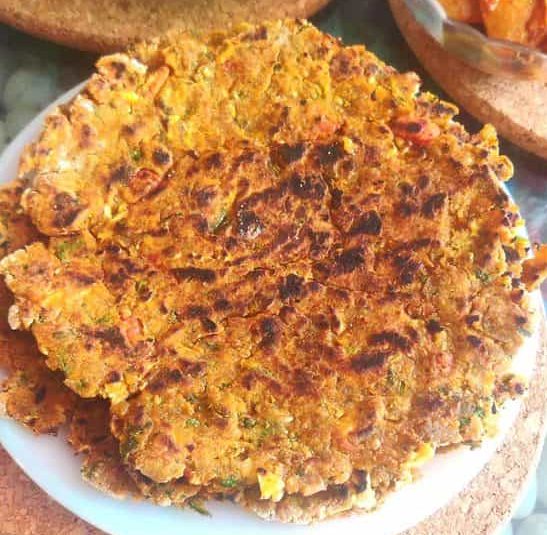
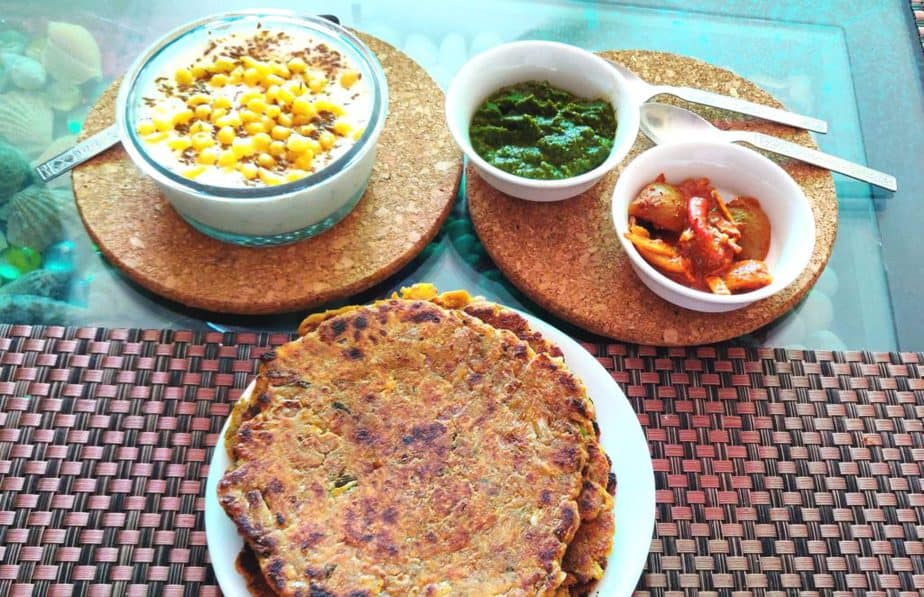
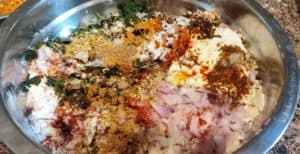
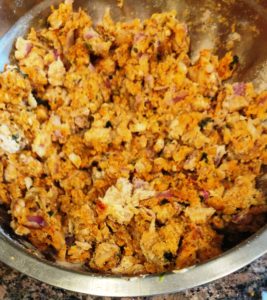
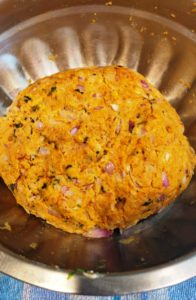
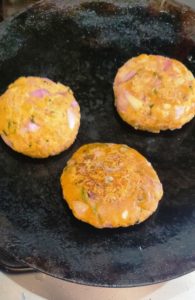
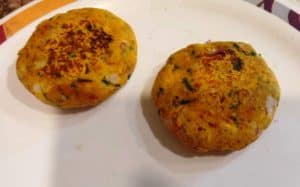
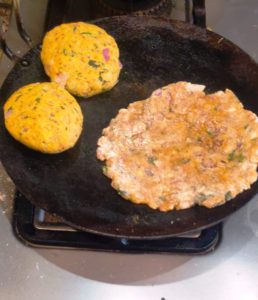
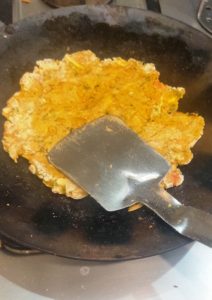
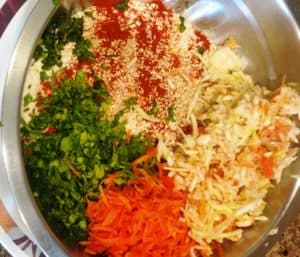

Trackbacks/Pingbacks